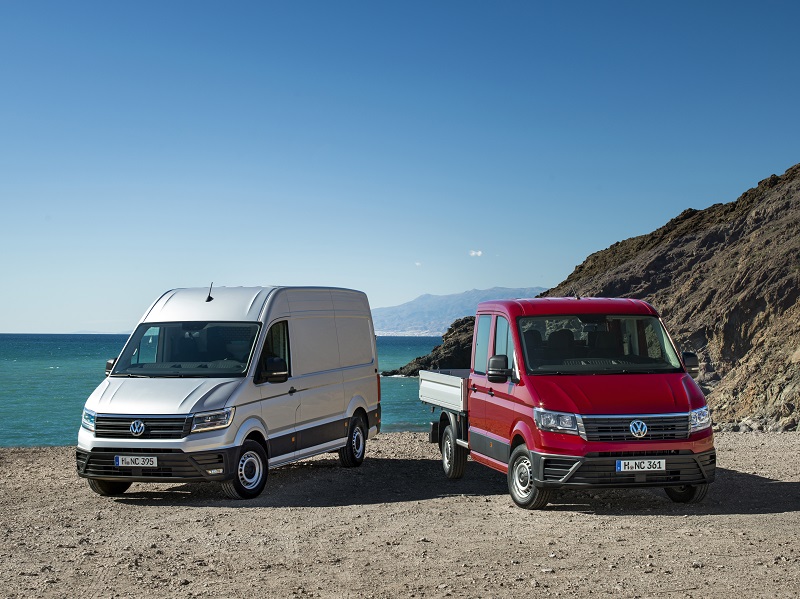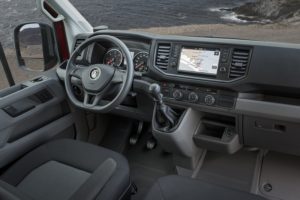
The setting for the iconic spaghetti westerns of the sixties, Construction Plant News was invited to another big showdown in the Andalusian winter sunshine.
Two big vans that once had so much in common are now quite literally ‘Poles’ apart. It follows a decision by VAG to establish its own factory in Wrzesnia to manufacture a new version of the highly regarded Crafter panel van.
Previously constructed on the same body platform as the Mercedes Sprinter in Germany, one can only imagine the high-powered boardroom dialogues which led to the split, but VAG is not a company to be denied and has spent the best part of 800 million Euros on a purpose-built plant, which for now at least, will produce an exclusive range of four base models of the new Crafter.
First launched in 2006 to replace the LT Van, the latest design has been four years in the planning and follows extensive customer research into the particular likes and dislikes of a diverse range of potential customers.
The result is the widest range of models in its class, panel van, single/double cab, dropside and tipper in three heights and three lengths comprising up to 69 derivatives in total.
 Going it alone has also enabled VAG to draw on the design structure and quality of its little brother, the iconic sixth generation Transporter, to maximise uptime and reduce total cost of ownership with a predicted 15 per cent higher fuel efficiency compared to its predecessor.
Going it alone has also enabled VAG to draw on the design structure and quality of its little brother, the iconic sixth generation Transporter, to maximise uptime and reduce total cost of ownership with a predicted 15 per cent higher fuel efficiency compared to its predecessor.
This is possible thanks in part to a combination of wind optimising measures to achieve a 0.33 drag coefficient, which we are reliably informed is the best in class. Correspondingly, emissions are reduced, meaning the vehicle is permitted to operate in all central urban zones.
With its corporate slim grille sporting a large central badge, and deep crease running along the underside of the door handles then down the length of the body, it’s clear that the new Crafter draws heavily on the exterior influences of the Transporter, which is at the heart of the company’s commercial vehicle brand.
Whilst never achieving the same sort of profile as some of its core rivals in its sector, with sales of over 50,000
worldwide in 2015, 8,000 of which were in the UK, the company will now be focused of establishing the Crafter as a significant third pillar of its commercial vehicle brand.
To this end, much of the design focus has been centred on the interior to provide the biggest possible payload and large cargo capacity with a comfortable driver’s workplace and cutting edge vehicle technology. The base panel van offers three roof heights and three load lengths with front, rear or four motion four wheel drive.
It all means that the new Crafter can offer gross weights of up to 5.5 tonnes, cargo volumes up to 18.4m³ and load heights up to 2,196mm.
 Access to the rear is particularly good with side hinged rear doors that open to 270 degrees where a clever magnetic door stop locks them in place and prevents them from impacting the side of the van. The sliding side doors open to a huge 1,311mm providing easy access from all angles.
Access to the rear is particularly good with side hinged rear doors that open to 270 degrees where a clever magnetic door stop locks them in place and prevents them from impacting the side of the van. The sliding side doors open to a huge 1,311mm providing easy access from all angles.
A lot of thought has gone into the configuration of the sturdy cab with plenty of coherent and practical storage areas for the host of personal accessories needed in today’s frantic business world.
The central passenger seat can be folded down to create a desk and a 12 volt power outlet is useful for charging up tools and devices on the move.
There’s plenty of adjustments available to both seats and steering wheel although the optional ergoComfort seat with a shock cushioning system takes a bit of getting used to and personally left this driver feeling a little queasy on some of the more undulating parts of the route.
Even so the company is proud of the fact that the Crafter is the first van in its sector to have the AGR Seal of Approval from the German campaign for healthier backs and with the Ero Active option can even provide a message. Where will it end?
All of the Crafter’s engines are 2.0 litre units from VW’s EA 288 family of commercial vehicle units, so they have a proven pedigree for durability, low down pulling power and efficiency.
 All are Euro 6 compliant common rail injection engines with an advanced SCR Catalytic convertor system to clean the exhaust gases. A stop/start system is standard and MPG returns are impressive but not quite market leading.
All are Euro 6 compliant common rail injection engines with an advanced SCR Catalytic convertor system to clean the exhaust gases. A stop/start system is standard and MPG returns are impressive but not quite market leading.
Infotainment and safety technology has also been carried over, so the Crafter now benefits from standard features such as four airbags, ESP stability control, automatic post collision braking system and side wind assist, while adaptive cruise control, lane assist and front assist emergency braking are options – and it doesn’t end there.
The VAG boffins have come up with a very clever, Trailer Asist, using a joystick control for the electric side windows to turn reversing a trailer in to an extremely tight spot something even we could manage at the first attempt although such wizardry obviously comes with a heavy premium.
On the road it all comes together to provide a ride which is right up there with the best of what this large van sector has to offer.
In fact there was never a moment on our stunning drive amongst the foothills of the imposing Sierra Nevada that our test vehicles were ever less than composed in tackling the sharp bends, steep gradients and, of course, the ubiquitous farm traffic taking the local produce to markets around the world.
At an entry price of around £23,000 the new Crafter may not be the cheapest large LCV on the market, but just look at what you can get ‘For a Few Dollars More’
For further information on the VW Crafter click here.








